Analysis of Civil Law, Torts, and Negligence in Workplace Safety
VerifiedAdded on 2020/11/12
|10
|1348
|418
Report
AI Summary
This report provides a comprehensive analysis of tort law and negligence, focusing on workplace safety within the context of a construction site accident. It begins by defining civil law and its purpose, differentiating it from criminal law, and then delves into the concept of tort law, categorizing different types of torts and their implications. The report examines the essential elements of negligence, including duty, breach, damage, and causation, which are crucial for establishing liability. A specific case study involving the death of an employee at a Canberra construction site is then analyzed, identifying the plaintiffs and defendants, and assessing the elements of negligence concerning the defendants' actions. The report further explores the social implications and consequences of holding defendants liable for negligence, highlighting the importance of setting precedents and creating awareness for improved workplace safety standards. The conclusion reinforces the significance of civil and tort laws, emphasizing the need for their strict implementation to minimize injustice and prevent future instances of negligence.

Construction
Paraphrase This Document
Need a fresh take? Get an instant paraphrase of this document with our AI Paraphraser
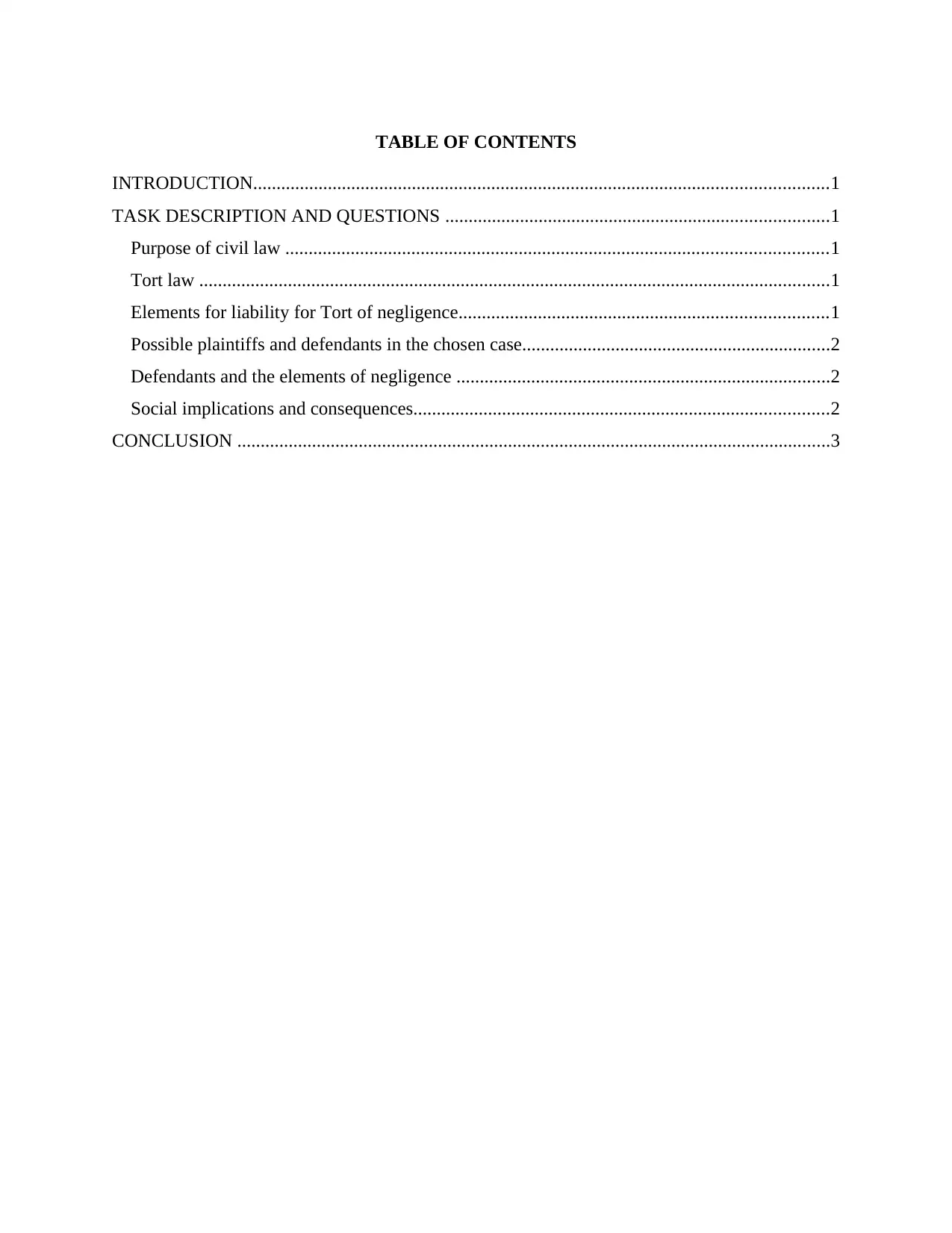
TABLE OF CONTENTS
INTRODUCTION...........................................................................................................................1
TASK DESCRIPTION AND QUESTIONS ..................................................................................1
Purpose of civil law ....................................................................................................................1
Tort law .......................................................................................................................................1
Elements for liability for Tort of negligence...............................................................................1
Possible plaintiffs and defendants in the chosen case..................................................................2
Defendants and the elements of negligence ................................................................................2
Social implications and consequences.........................................................................................2
CONCLUSION ...............................................................................................................................3
INTRODUCTION...........................................................................................................................1
TASK DESCRIPTION AND QUESTIONS ..................................................................................1
Purpose of civil law ....................................................................................................................1
Tort law .......................................................................................................................................1
Elements for liability for Tort of negligence...............................................................................1
Possible plaintiffs and defendants in the chosen case..................................................................2
Defendants and the elements of negligence ................................................................................2
Social implications and consequences.........................................................................................2
CONCLUSION ...............................................................................................................................3
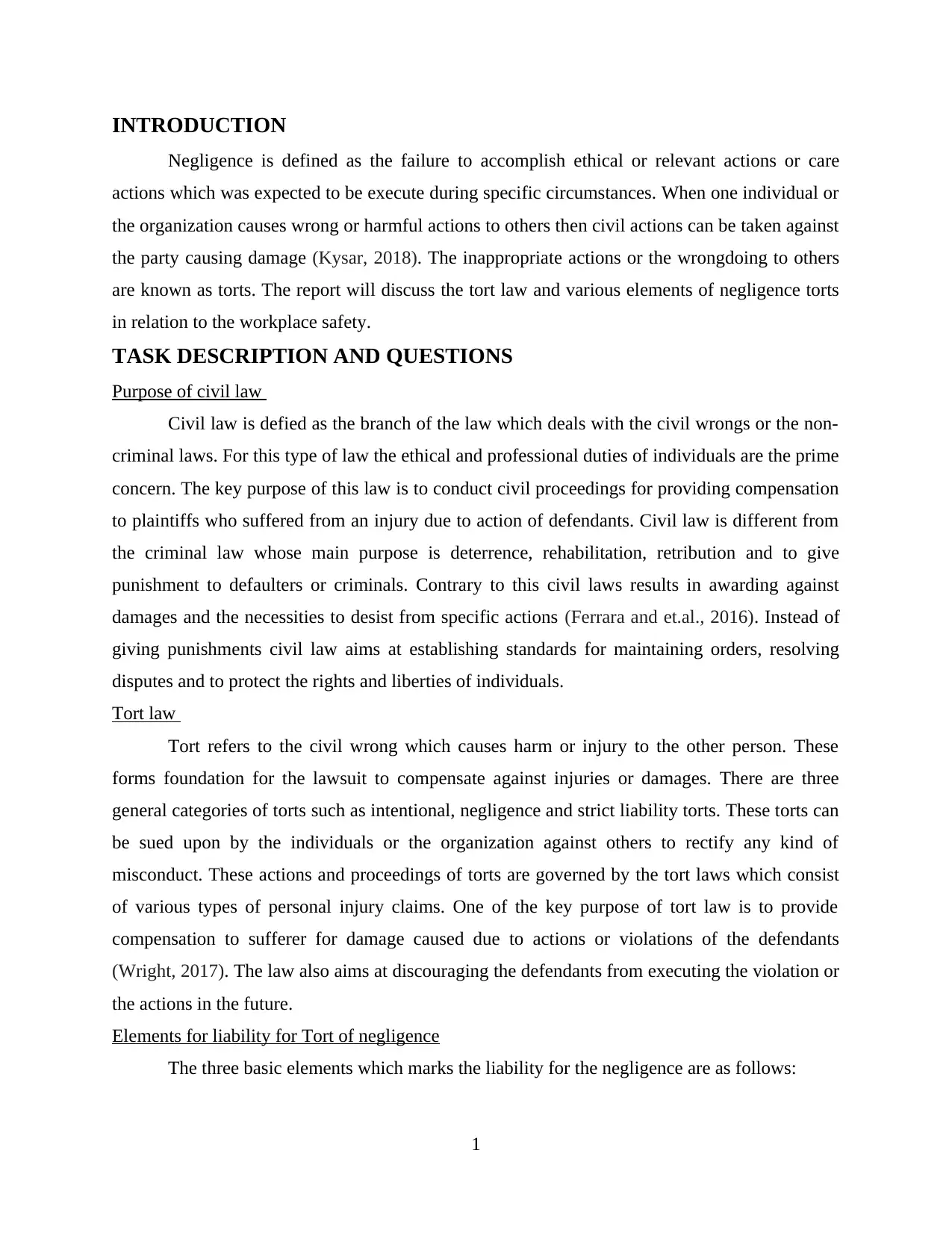
INTRODUCTION
Negligence is defined as the failure to accomplish ethical or relevant actions or care
actions which was expected to be execute during specific circumstances. When one individual or
the organization causes wrong or harmful actions to others then civil actions can be taken against
the party causing damage (Kysar, 2018). The inappropriate actions or the wrongdoing to others
are known as torts. The report will discuss the tort law and various elements of negligence torts
in relation to the workplace safety.
TASK DESCRIPTION AND QUESTIONS
Purpose of civil law
Civil law is defied as the branch of the law which deals with the civil wrongs or the non-
criminal laws. For this type of law the ethical and professional duties of individuals are the prime
concern. The key purpose of this law is to conduct civil proceedings for providing compensation
to plaintiffs who suffered from an injury due to action of defendants. Civil law is different from
the criminal law whose main purpose is deterrence, rehabilitation, retribution and to give
punishment to defaulters or criminals. Contrary to this civil laws results in awarding against
damages and the necessities to desist from specific actions (Ferrara and et.al., 2016). Instead of
giving punishments civil law aims at establishing standards for maintaining orders, resolving
disputes and to protect the rights and liberties of individuals.
Tort law
Tort refers to the civil wrong which causes harm or injury to the other person. These
forms foundation for the lawsuit to compensate against injuries or damages. There are three
general categories of torts such as intentional, negligence and strict liability torts. These torts can
be sued upon by the individuals or the organization against others to rectify any kind of
misconduct. These actions and proceedings of torts are governed by the tort laws which consist
of various types of personal injury claims. One of the key purpose of tort law is to provide
compensation to sufferer for damage caused due to actions or violations of the defendants
(Wright, 2017). The law also aims at discouraging the defendants from executing the violation or
the actions in the future.
Elements for liability for Tort of negligence
The three basic elements which marks the liability for the negligence are as follows:
1
Negligence is defined as the failure to accomplish ethical or relevant actions or care
actions which was expected to be execute during specific circumstances. When one individual or
the organization causes wrong or harmful actions to others then civil actions can be taken against
the party causing damage (Kysar, 2018). The inappropriate actions or the wrongdoing to others
are known as torts. The report will discuss the tort law and various elements of negligence torts
in relation to the workplace safety.
TASK DESCRIPTION AND QUESTIONS
Purpose of civil law
Civil law is defied as the branch of the law which deals with the civil wrongs or the non-
criminal laws. For this type of law the ethical and professional duties of individuals are the prime
concern. The key purpose of this law is to conduct civil proceedings for providing compensation
to plaintiffs who suffered from an injury due to action of defendants. Civil law is different from
the criminal law whose main purpose is deterrence, rehabilitation, retribution and to give
punishment to defaulters or criminals. Contrary to this civil laws results in awarding against
damages and the necessities to desist from specific actions (Ferrara and et.al., 2016). Instead of
giving punishments civil law aims at establishing standards for maintaining orders, resolving
disputes and to protect the rights and liberties of individuals.
Tort law
Tort refers to the civil wrong which causes harm or injury to the other person. These
forms foundation for the lawsuit to compensate against injuries or damages. There are three
general categories of torts such as intentional, negligence and strict liability torts. These torts can
be sued upon by the individuals or the organization against others to rectify any kind of
misconduct. These actions and proceedings of torts are governed by the tort laws which consist
of various types of personal injury claims. One of the key purpose of tort law is to provide
compensation to sufferer for damage caused due to actions or violations of the defendants
(Wright, 2017). The law also aims at discouraging the defendants from executing the violation or
the actions in the future.
Elements for liability for Tort of negligence
The three basic elements which marks the liability for the negligence are as follows:
1
⊘ This is a preview!⊘
Do you want full access?
Subscribe today to unlock all pages.

Trusted by 1+ million students worldwide
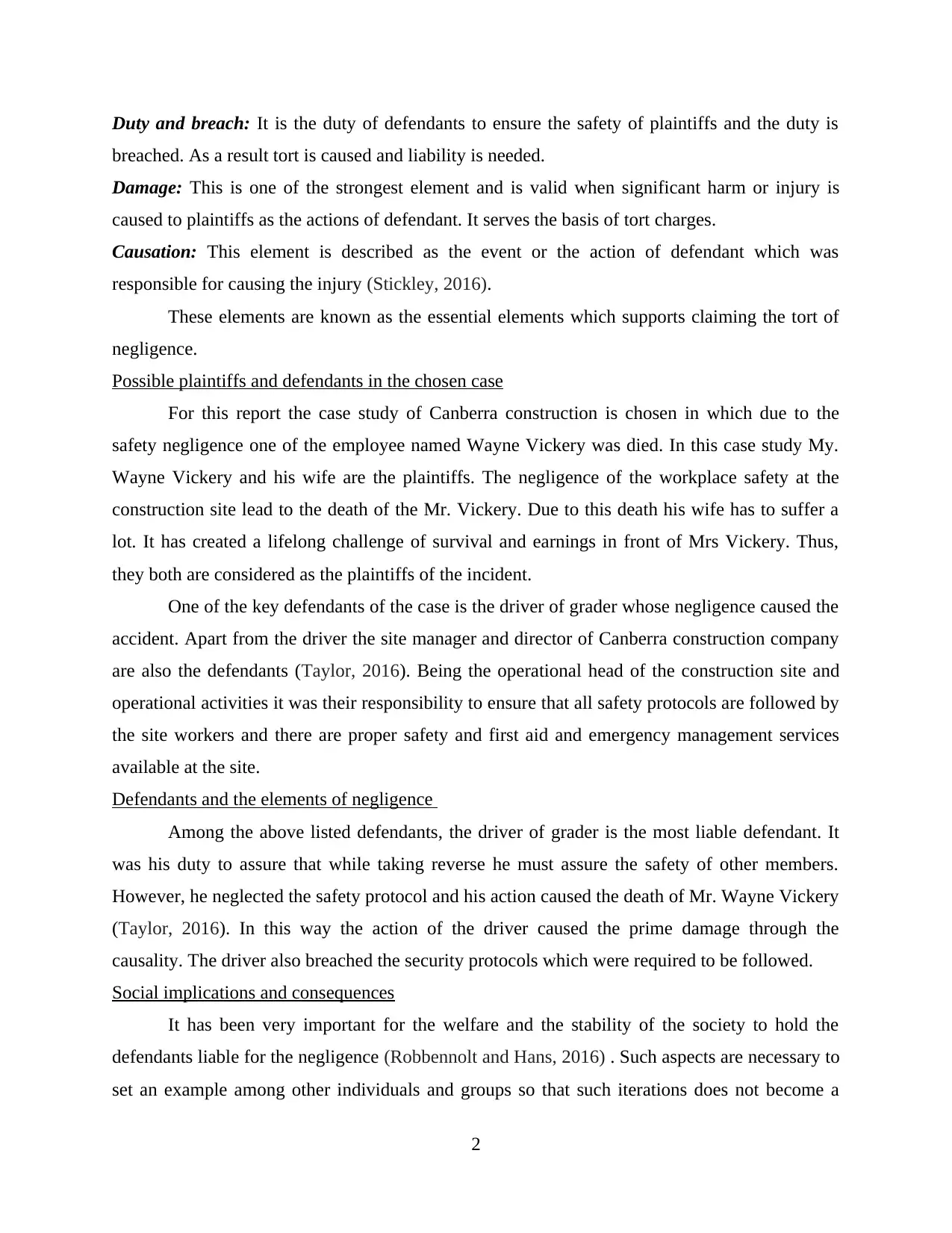
Duty and breach: It is the duty of defendants to ensure the safety of plaintiffs and the duty is
breached. As a result tort is caused and liability is needed.
Damage: This is one of the strongest element and is valid when significant harm or injury is
caused to plaintiffs as the actions of defendant. It serves the basis of tort charges.
Causation: This element is described as the event or the action of defendant which was
responsible for causing the injury (Stickley, 2016).
These elements are known as the essential elements which supports claiming the tort of
negligence.
Possible plaintiffs and defendants in the chosen case
For this report the case study of Canberra construction is chosen in which due to the
safety negligence one of the employee named Wayne Vickery was died. In this case study My.
Wayne Vickery and his wife are the plaintiffs. The negligence of the workplace safety at the
construction site lead to the death of the Mr. Vickery. Due to this death his wife has to suffer a
lot. It has created a lifelong challenge of survival and earnings in front of Mrs Vickery. Thus,
they both are considered as the plaintiffs of the incident.
One of the key defendants of the case is the driver of grader whose negligence caused the
accident. Apart from the driver the site manager and director of Canberra construction company
are also the defendants (Taylor, 2016). Being the operational head of the construction site and
operational activities it was their responsibility to ensure that all safety protocols are followed by
the site workers and there are proper safety and first aid and emergency management services
available at the site.
Defendants and the elements of negligence
Among the above listed defendants, the driver of grader is the most liable defendant. It
was his duty to assure that while taking reverse he must assure the safety of other members.
However, he neglected the safety protocol and his action caused the death of Mr. Wayne Vickery
(Taylor, 2016). In this way the action of the driver caused the prime damage through the
causality. The driver also breached the security protocols which were required to be followed.
Social implications and consequences
It has been very important for the welfare and the stability of the society to hold the
defendants liable for the negligence (Robbennolt and Hans, 2016) . Such aspects are necessary to
set an example among other individuals and groups so that such iterations does not become a
2
breached. As a result tort is caused and liability is needed.
Damage: This is one of the strongest element and is valid when significant harm or injury is
caused to plaintiffs as the actions of defendant. It serves the basis of tort charges.
Causation: This element is described as the event or the action of defendant which was
responsible for causing the injury (Stickley, 2016).
These elements are known as the essential elements which supports claiming the tort of
negligence.
Possible plaintiffs and defendants in the chosen case
For this report the case study of Canberra construction is chosen in which due to the
safety negligence one of the employee named Wayne Vickery was died. In this case study My.
Wayne Vickery and his wife are the plaintiffs. The negligence of the workplace safety at the
construction site lead to the death of the Mr. Vickery. Due to this death his wife has to suffer a
lot. It has created a lifelong challenge of survival and earnings in front of Mrs Vickery. Thus,
they both are considered as the plaintiffs of the incident.
One of the key defendants of the case is the driver of grader whose negligence caused the
accident. Apart from the driver the site manager and director of Canberra construction company
are also the defendants (Taylor, 2016). Being the operational head of the construction site and
operational activities it was their responsibility to ensure that all safety protocols are followed by
the site workers and there are proper safety and first aid and emergency management services
available at the site.
Defendants and the elements of negligence
Among the above listed defendants, the driver of grader is the most liable defendant. It
was his duty to assure that while taking reverse he must assure the safety of other members.
However, he neglected the safety protocol and his action caused the death of Mr. Wayne Vickery
(Taylor, 2016). In this way the action of the driver caused the prime damage through the
causality. The driver also breached the security protocols which were required to be followed.
Social implications and consequences
It has been very important for the welfare and the stability of the society to hold the
defendants liable for the negligence (Robbennolt and Hans, 2016) . Such aspects are necessary to
set an example among other individuals and groups so that such iterations does not become a
2
Paraphrase This Document
Need a fresh take? Get an instant paraphrase of this document with our AI Paraphraser
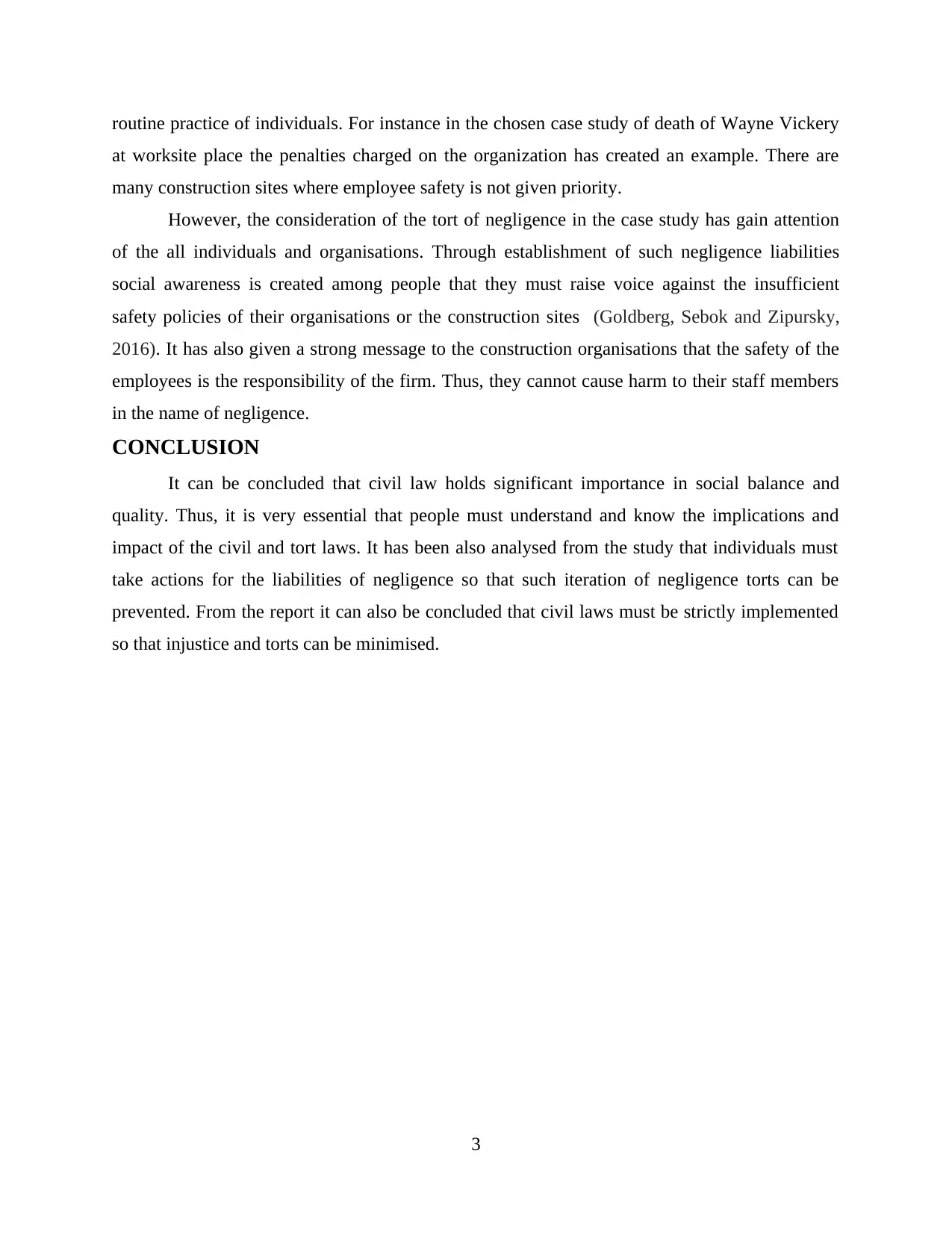
routine practice of individuals. For instance in the chosen case study of death of Wayne Vickery
at worksite place the penalties charged on the organization has created an example. There are
many construction sites where employee safety is not given priority.
However, the consideration of the tort of negligence in the case study has gain attention
of the all individuals and organisations. Through establishment of such negligence liabilities
social awareness is created among people that they must raise voice against the insufficient
safety policies of their organisations or the construction sites (Goldberg, Sebok and Zipursky,
2016). It has also given a strong message to the construction organisations that the safety of the
employees is the responsibility of the firm. Thus, they cannot cause harm to their staff members
in the name of negligence.
CONCLUSION
It can be concluded that civil law holds significant importance in social balance and
quality. Thus, it is very essential that people must understand and know the implications and
impact of the civil and tort laws. It has been also analysed from the study that individuals must
take actions for the liabilities of negligence so that such iteration of negligence torts can be
prevented. From the report it can also be concluded that civil laws must be strictly implemented
so that injustice and torts can be minimised.
3
at worksite place the penalties charged on the organization has created an example. There are
many construction sites where employee safety is not given priority.
However, the consideration of the tort of negligence in the case study has gain attention
of the all individuals and organisations. Through establishment of such negligence liabilities
social awareness is created among people that they must raise voice against the insufficient
safety policies of their organisations or the construction sites (Goldberg, Sebok and Zipursky,
2016). It has also given a strong message to the construction organisations that the safety of the
employees is the responsibility of the firm. Thus, they cannot cause harm to their staff members
in the name of negligence.
CONCLUSION
It can be concluded that civil law holds significant importance in social balance and
quality. Thus, it is very essential that people must understand and know the implications and
impact of the civil and tort laws. It has been also analysed from the study that individuals must
take actions for the liabilities of negligence so that such iteration of negligence torts can be
prevented. From the report it can also be concluded that civil laws must be strictly implemented
so that injustice and torts can be minimised.
3
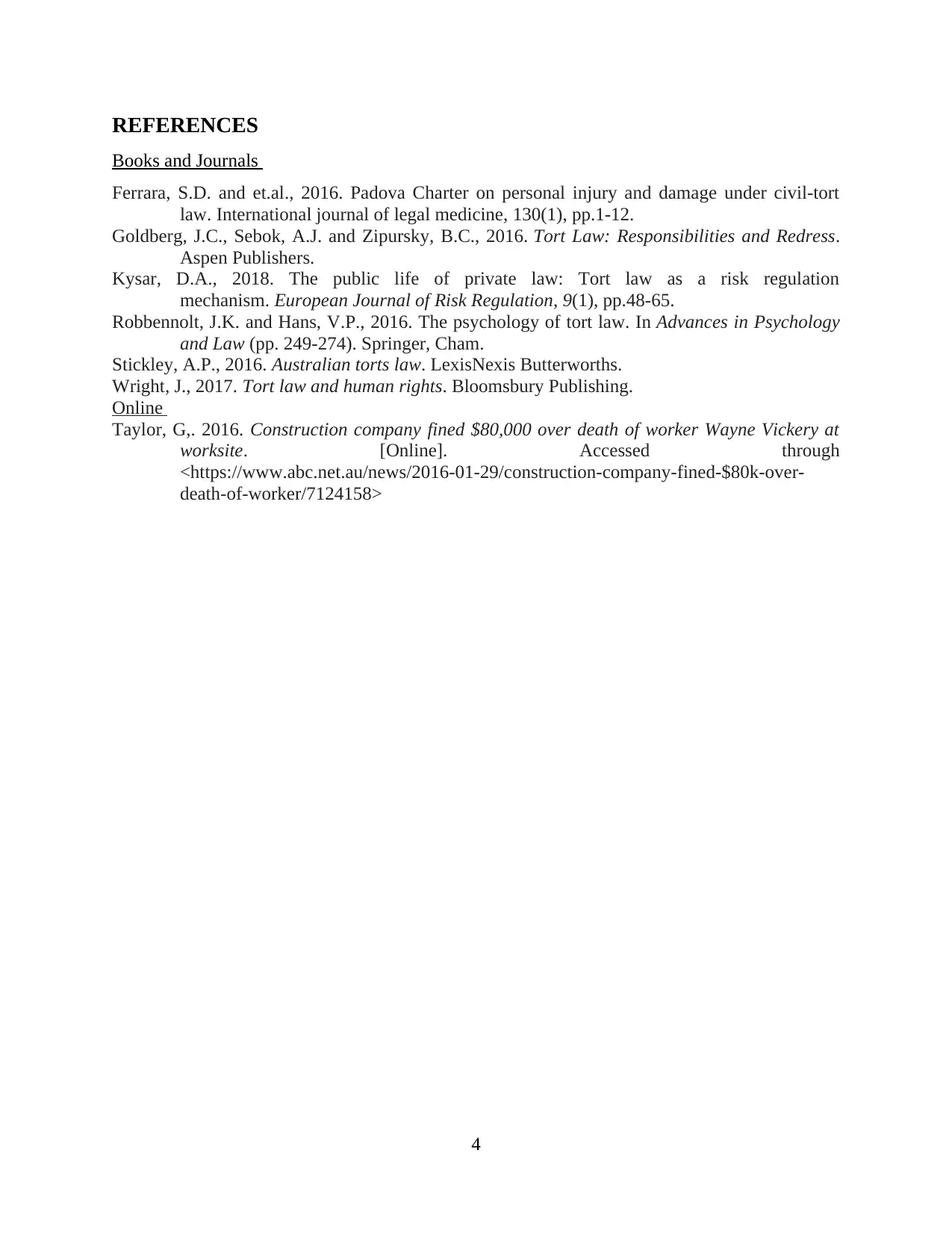
REFERENCES
Books and Journals
Ferrara, S.D. and et.al., 2016. Padova Charter on personal injury and damage under civil-tort
law. International journal of legal medicine, 130(1), pp.1-12.
Goldberg, J.C., Sebok, A.J. and Zipursky, B.C., 2016. Tort Law: Responsibilities and Redress.
Aspen Publishers.
Kysar, D.A., 2018. The public life of private law: Tort law as a risk regulation
mechanism. European Journal of Risk Regulation, 9(1), pp.48-65.
Robbennolt, J.K. and Hans, V.P., 2016. The psychology of tort law. In Advances in Psychology
and Law (pp. 249-274). Springer, Cham.
Stickley, A.P., 2016. Australian torts law. LexisNexis Butterworths.
Wright, J., 2017. Tort law and human rights. Bloomsbury Publishing.
Online
Taylor, G,. 2016. Construction company fined $80,000 over death of worker Wayne Vickery at
worksite. [Online]. Accessed through
<https://www.abc.net.au/news/2016-01-29/construction-company-fined-$80k-over-
death-of-worker/7124158>
4
Books and Journals
Ferrara, S.D. and et.al., 2016. Padova Charter on personal injury and damage under civil-tort
law. International journal of legal medicine, 130(1), pp.1-12.
Goldberg, J.C., Sebok, A.J. and Zipursky, B.C., 2016. Tort Law: Responsibilities and Redress.
Aspen Publishers.
Kysar, D.A., 2018. The public life of private law: Tort law as a risk regulation
mechanism. European Journal of Risk Regulation, 9(1), pp.48-65.
Robbennolt, J.K. and Hans, V.P., 2016. The psychology of tort law. In Advances in Psychology
and Law (pp. 249-274). Springer, Cham.
Stickley, A.P., 2016. Australian torts law. LexisNexis Butterworths.
Wright, J., 2017. Tort law and human rights. Bloomsbury Publishing.
Online
Taylor, G,. 2016. Construction company fined $80,000 over death of worker Wayne Vickery at
worksite. [Online]. Accessed through
<https://www.abc.net.au/news/2016-01-29/construction-company-fined-$80k-over-
death-of-worker/7124158>
4
⊘ This is a preview!⊘
Do you want full access?
Subscribe today to unlock all pages.

Trusted by 1+ million students worldwide

5
Paraphrase This Document
Need a fresh take? Get an instant paraphrase of this document with our AI Paraphraser

6

7
⊘ This is a preview!⊘
Do you want full access?
Subscribe today to unlock all pages.

Trusted by 1+ million students worldwide

8
1 out of 10
Related Documents
Your All-in-One AI-Powered Toolkit for Academic Success.
+13062052269
info@desklib.com
Available 24*7 on WhatsApp / Email
![[object Object]](/_next/static/media/star-bottom.7253800d.svg)
Unlock your academic potential
Copyright © 2020–2025 A2Z Services. All Rights Reserved. Developed and managed by ZUCOL.




